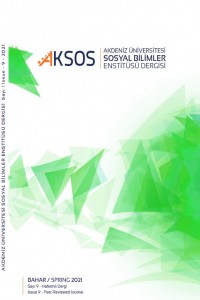Öz
Kitle iletişiminin İkinci Dünya Savaşı’nın ardından geliştirilmesi toplum iletişimi ile bağlantılı olarak yaşam biçimlerinin de değişmesine neden olmuştur. Bu durum, popüler kültürün yaygınlaşıp bireyin, çevre faktörünün dönüşüm yaşadığı bir süreci de beraberinde getirmiştir. Oluşan bu toplumsal yapı ve büyük dönüşüm, sanat üsluplarında tema, yöntem, mekân anlayışında ve dönem estetik yöntem, düşünce yapısında büyük farklılıkların oluşumuna zemin oluşturmuştur. Bu değişimde özellikle döneme hâkim olan reklam ve marka bilinci, popüler film ve televizyon kültürünün yaygınlaşması, imajların görsel kültürde öne çıkışının etkisi olmuştur. Bu bağlamda; sanatçılar da sanat eseri üretimlerinde farklı malzeme duyarlılığı ve yeni bir görsel dil inşa etme sürecini başlatmışlardır. Rauschenberg’in bu dönemde Amerikan avangard sanatına hâkim olan soyut dışavurumcu üslubu reddetmesi, rastlantısal nesnelerle oluşturduğu combine resimlerini geliştirmesine zemin hazırlamıştır. Bu süreçte Robert Rauschenberg, sanat tarihinde 1950’li yıllara kadar izlediğimiz hazır nesne kullanım unsurlarından farklı olarak hurdalıklara giderek nesne arayışına girmeden kendi aktiviteleri sırasında keşfettiği objelerin birleşimi ile üslubunu geliştirmiştir. Rauschenberg’ın eserlerinde kullanılan nesneler sanatçının sosyal hayatında maruz kaldığı görsel kültürün de bir sentezini oluşturmakta idi. Bu bağlamda makalede; Robert Rauschenberg’ın (1925-2008) “Combine Sanat” üretim örneklemleri ile dönem görsel kültürü nitel bir araştırma yöntemi ile araştırılacak, sanatçının “Combine Sanat” eserlerinin sanatta malzeme kullanımında yarattığı değişim incelenecektir.
Anahtar Kelimeler
Kaynakça
- Antmen, A. (2000). A’dan Z’ye Yirminci Yüzyıl Sanatı. P Sanat ve Kültür Dergisi, Sayı: 16: 65-67.
- Antmen, A. (2010). 20. Yüzyıl Batı Sanatında Akımlar. İstanbul: Sel Yayıncılık.
- Antmen, A. (2010). 20. Yüzyıl Batı Sanatında Akımlar. İstanbul: Sel Yayıncılık.
- Baudaille, G. (1995). Jasper Johns. London: Academy Editions.
- Bayçu, S. (2018). Robert Rauschenberg, Ressam ve Eseri Üzerine Eğlenceye Dönüşen Sanat Pratiği, Resim. Sanat ve Tasarım Dergisi. Aralık, 33-47.
- Cabanne, P. (1997). Kolajlar. (Der. Batur E.), Modernizmin Serüveni. (s. 324-328). İstanbul: Yapı Kredi Yayınları.
- Cima, G. G. (1986). Shifting Perpectives: Combining Shepard and Rauschenberg. Theatre Journal, 38, March, 67-81.
- Fıneberg, J. (1995). Art Since 1940. New York: Laurence King.
- Fıneberg, J. (2014). 1940’dan Günümüze Sanat. İzmir: Karakalem Kitabevi.
- Genç, A. (1983). Antropi ve Nedensizlik Açısından Dadacı Sanat Hareketlerinin Çözümlenmesi. Yayınlanmış Doktora Tezi. Dokuz Eylül Üniversitesi, İzmir.
- Honour, H., Fleming, J. (2016). Dünya Sanat Tarihi. Çev: Hakan Abacı. İstanbul: Alfa Yayıncılık.
- Steinberg, L. (2000). Encounters with Rauschenberg. New York: The Unıversity of Chicago.
Öz
Development of mass communication after the Second World War also led to a change in lifestyles in connection with community communication. This change also led to a process, in which popular culture became widespread and individuals experienced a transformation in the environmental factor. Resulting social structure and great transformation formed the basis for formation of great changes in the understanding of theme, method, time in art trends, in the structure of method and thought of the period. Especially advertising and brand awareness, which dominated that period, prevalence of popular film and television culture and emergence of images in visual culture played a significant role in this change. In this context, artists also started the process of building different material sensitivities and a new visual language in their art work production processes. Rauschenberg’s rejection of the Abstract Expressionist style that dominated American Avant-Garde Art during this period formed a basis for his development of combine paintings that he created with random objects. In this process, instead of using ready-made objects, which was a dominant approach in the history of Art until 1950s, without going to junk yards and looking for objects, Robert Rauschenberg developed his own style by combining objects he discovered during his art-works. Objects and items Rauschenberg used in his works were also a synthesis of the visual culture he was exposed to during his social life. In this context, Robert Rauschenberg’s (1925-2008) “Combine Art” production samples and the visual culture of that period will be analyzed by means of a qualitative research method in this article, and the change created by the artist’s “Combine Art” works in terms of material use in the art will be examined.
Anahtar Kelimeler
Kaynakça
- Antmen, A. (2000). A’dan Z’ye Yirminci Yüzyıl Sanatı. P Sanat ve Kültür Dergisi, Sayı: 16: 65-67.
- Antmen, A. (2010). 20. Yüzyıl Batı Sanatında Akımlar. İstanbul: Sel Yayıncılık.
- Antmen, A. (2010). 20. Yüzyıl Batı Sanatında Akımlar. İstanbul: Sel Yayıncılık.
- Baudaille, G. (1995). Jasper Johns. London: Academy Editions.
- Bayçu, S. (2018). Robert Rauschenberg, Ressam ve Eseri Üzerine Eğlenceye Dönüşen Sanat Pratiği, Resim. Sanat ve Tasarım Dergisi. Aralık, 33-47.
- Cabanne, P. (1997). Kolajlar. (Der. Batur E.), Modernizmin Serüveni. (s. 324-328). İstanbul: Yapı Kredi Yayınları.
- Cima, G. G. (1986). Shifting Perpectives: Combining Shepard and Rauschenberg. Theatre Journal, 38, March, 67-81.
- Fıneberg, J. (1995). Art Since 1940. New York: Laurence King.
- Fıneberg, J. (2014). 1940’dan Günümüze Sanat. İzmir: Karakalem Kitabevi.
- Genç, A. (1983). Antropi ve Nedensizlik Açısından Dadacı Sanat Hareketlerinin Çözümlenmesi. Yayınlanmış Doktora Tezi. Dokuz Eylül Üniversitesi, İzmir.
- Honour, H., Fleming, J. (2016). Dünya Sanat Tarihi. Çev: Hakan Abacı. İstanbul: Alfa Yayıncılık.
- Steinberg, L. (2000). Encounters with Rauschenberg. New York: The Unıversity of Chicago.
Ayrıntılar
| Birincil Dil | Türkçe |
|---|---|
| Bölüm | Makaleler |
| Yazarlar | |
| Yayımlanma Tarihi | 28 Mayıs 2021 |
| Gönderilme Tarihi | 28 Nisan 2021 |
| Yayımlandığı Sayı | Yıl 2021 Sayı: 9 |
Akdeniz Üniversitesi Sosyal Bilimler Enstitüsü Dergisi (AKSOS)


